Pumpkin is a special case in Russian cuisine. On the one hand, it is not very common. On the other hand, Russian cuisine seems incomplete without it. Of course, it can be chopped into pieces and stewed or roasted. But sooner or later every hostess has the idea of stuffing it with a delicious filling and baking in the oven.
Even our ancestors had a complicated relationship with pumpkin. In Ukrainian a pumpkin is гарбуз, used in the expression “to bring someone a гарбуз.” This is an ancient custom that means the family of the young woman — usually her parents — refuse a young man’s courting of their daughter for marriage. Polish ethnographer Oskar Henryk Kolberg (1814-1890) described a similar custom in Galicia, when the rejected groom was told that he had a “pumpkin nailed to him.”
The writer and journalist Grigory Kvitka (1778-1843) in his works "Wedding" and "Konotop Witch" elaborated on this process:
Vlasovich demanded, “Give me your sister Olena to me!”
The Cossack leader sniffed and said nothing. He only shouted back into the room, “Hey, sister! Bring us our breakfast, what have you cooked for us?"
The maid came into the room, bowed, and put a pan on the table in front of Vlasovich… in the pan was a stuffed pumpkin... The visitor saw the dish, jumped up from the table and ran out of the house. He jumped on his saddled horse, and as he galloped past houses he could hear everyone laughing at him! As soon as he rode out of the village he looked down.
“What is tied to the horse’s neck?
He looked closely: it was a rope. He pulled the rope… at the end was a pumpkin!
This custom gradually died out in the 19th century. As Russian and Ukrainian ethnographer Nikolai Sumtsov wrote in his book "Kyiv Antiquity" back in 1889, "The pumpkin ritual is rarely found these days. Instead of the action itself, only the expression ‘to bring a garbuz’ remains.”
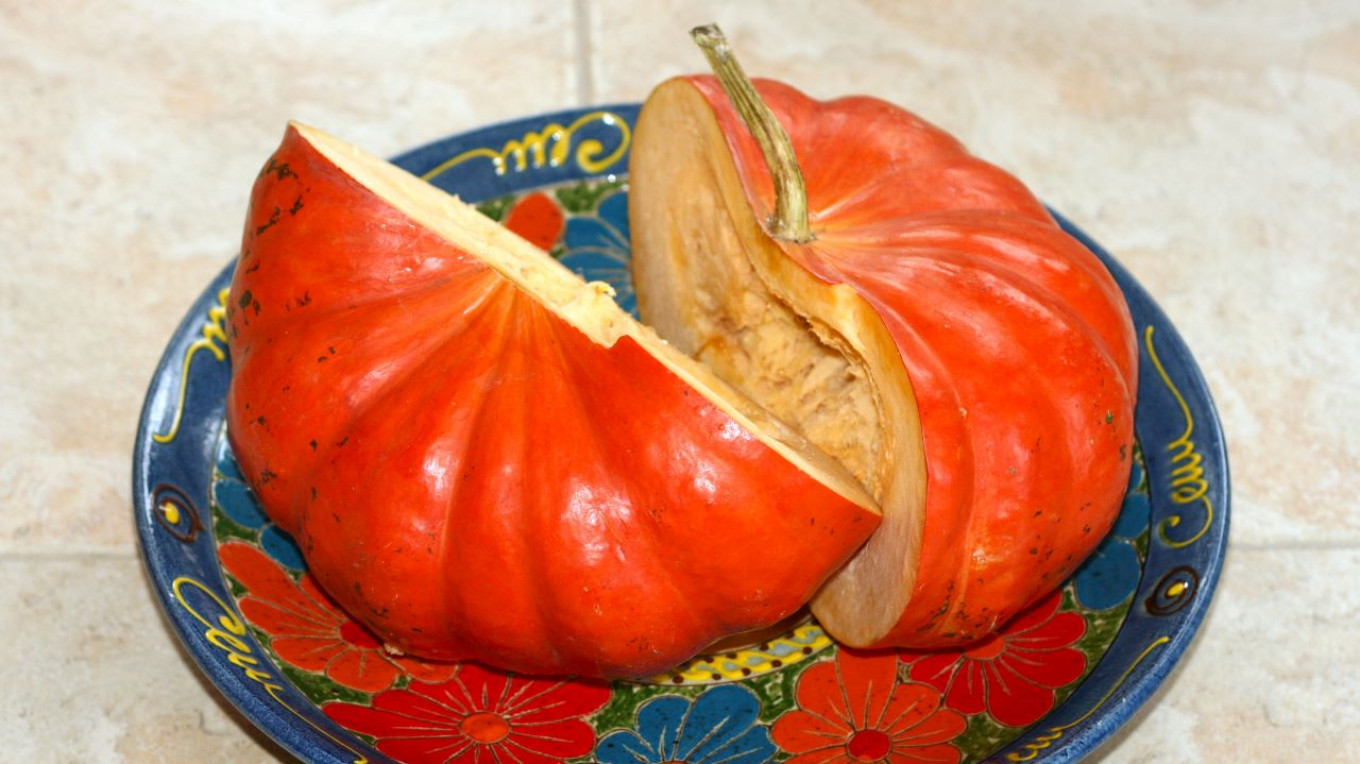
But the pumpkin was a double-edged sword, as it were. Sometimes the bride was hurt by it. The groom’s parents could put the pumpkin on the wedding table as a sign of the bride or her mother's dishonesty — whatever that meant.
The beginning of this custom goes back to antiquity. The word гарбуз is Eastern, probably Turkic. In that language it means watermelon. But in the 17th century in the lands that are now Ukraine, the word became synonymous with the common kitchen pumpkin (Cucūrbita māxima). Almost same name was also used for the pumpkin in Persia — "torbuz."
We love pumpkin because it is an almost inexhaustible material for culinary fantasies. Pies, soup, stews and even jam — pumpkin can be used everywhere.
But pumpkin is also part of Russian cuisine. It figures in the very first cookery books that appeared in the late 18th century. For example, the 1795 "Russian Cookery" by the famous culinary specialist Vasily Lyovshin introduces us to fried pumpkin and pumpkin stuffed with meat, pumpkin kasha (milk porridge with pureed pumpkin). There's also pureed pumpkin soup. The latter is a kind of imitation of Western traditions, but at the same time it is a good example of how our cuisine assimilated foreign experience. By the 18th century pumpkin had become quite a Russian vegetable.
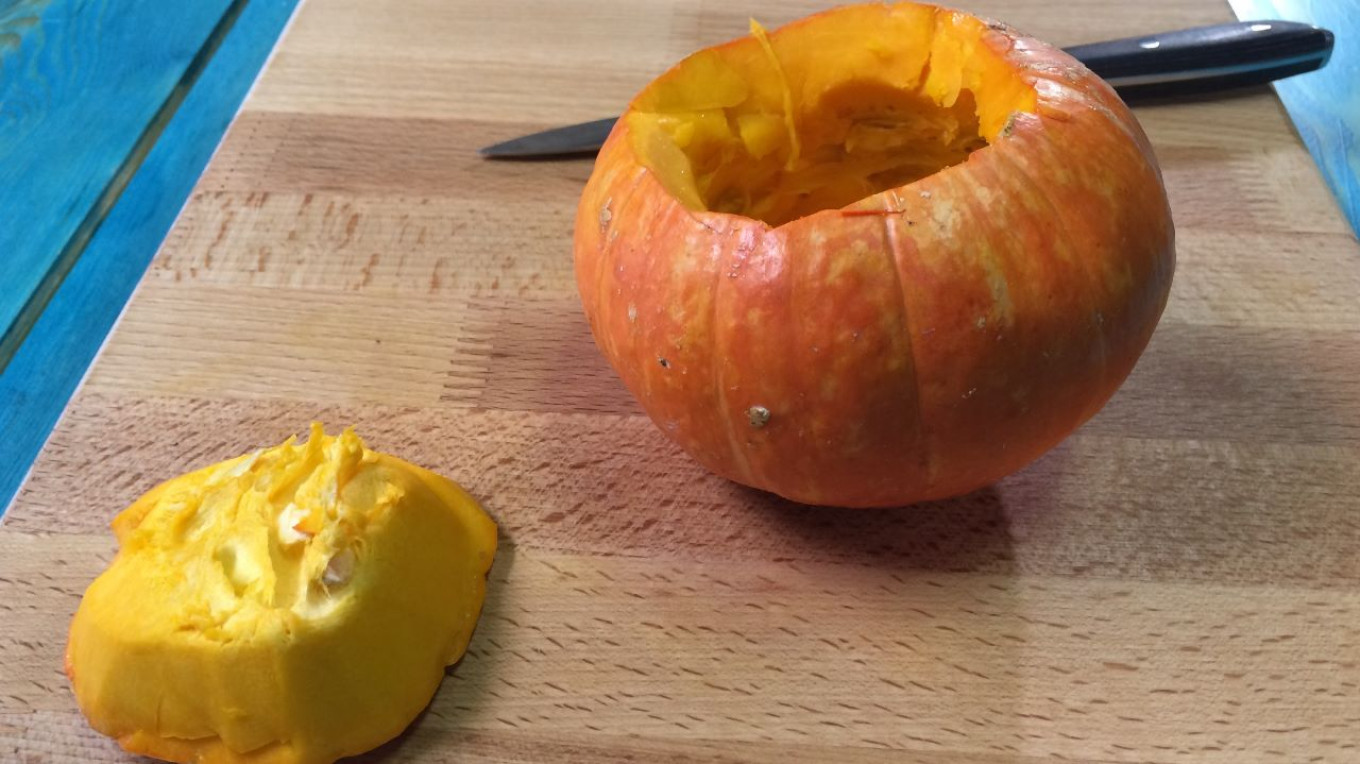
Pumpkin was especially popular in monasteries. Even in northern Valaam (on the same latitude as Helsinki and Reykjavik) gardeners achieved outstanding results. Melons reached 7 pounds, watermelons 20 pounds, and pumpkins 2 poods (32 kg). For these achievements, the monastery received several gold and silver medals at various all-Russian agricultural exhibitions in the second half of the 19th century.
We like stuffed pumpkin, too. We have slightly reworked this old recipe from Vasily Lyovshin's book. Here's what he writes in his 1795 “Russian Cookery”:
"Take a whole pumpkin, cut off the top skillfully so that the cut can be reattached, and clean out the inside with a spoon. Take beef, chop it with onions, fry in butter or sour cream, season with pepper and stuff the pumpkin artfully. As soon as you stuff the pumpkin, fasten the top with wooden matchsticks, put it in a pot, cover it and put in the oven and let it gently steam.”
Could you make stuffed pumpkin from that recipe? You see the problem. That was how all recipes were written in Russia until about the middle of the 19th century. They did not have today's grams, degrees and minutes. All operations were designed for a skilled chef, who understood what it meant to "stuff artfully" and "steam gently.” That's why all old recipes require adaptation today to suit modern tastes, products, and cooking techniques.
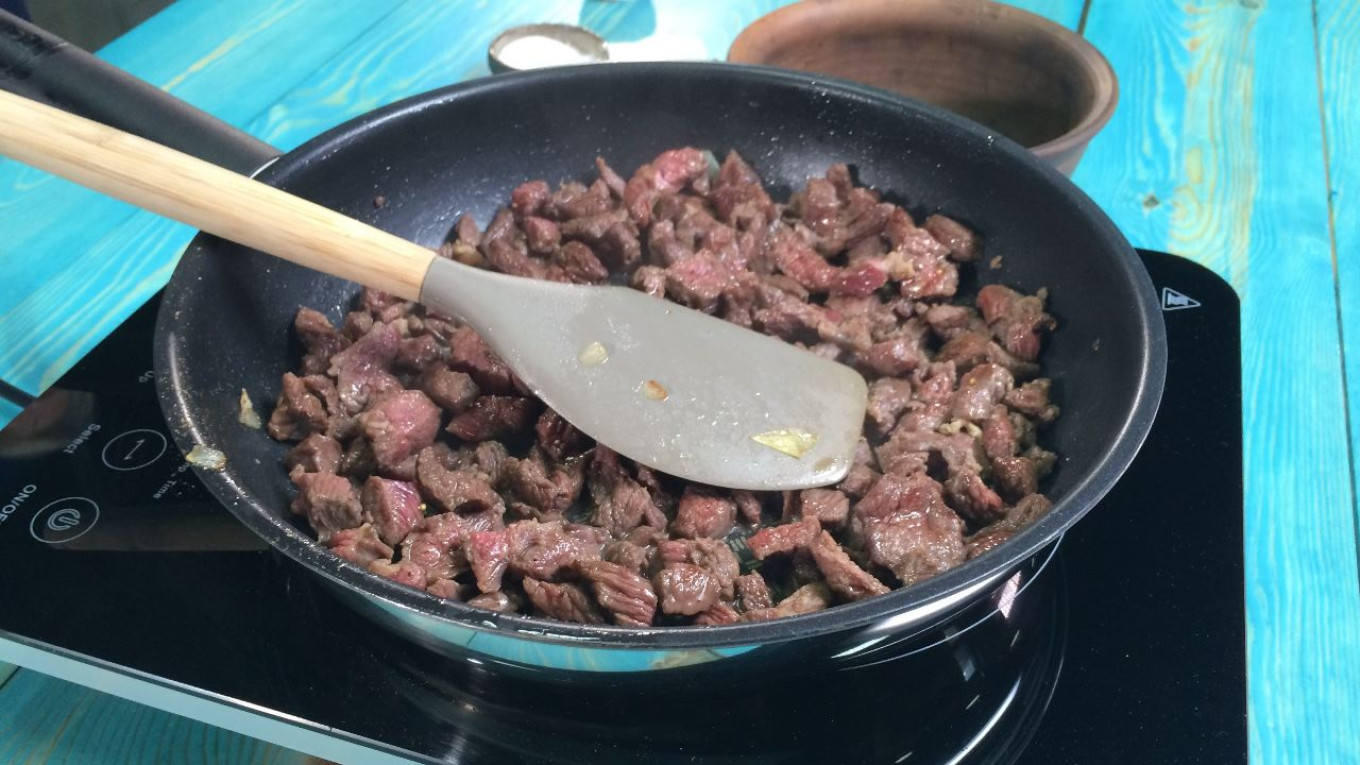
But if you think about it a little bit, this old pumpkin recipe can be adapted to modern tastes. We tried it and it turned out to be delicious. No wonder a pumpkin is transformed in fairy tales! A hostess can surprise her guests with this dish. Just be careful — your daughter’s boyfriend might not like it.
Or maybe he will. After all, who remembers old customs today?
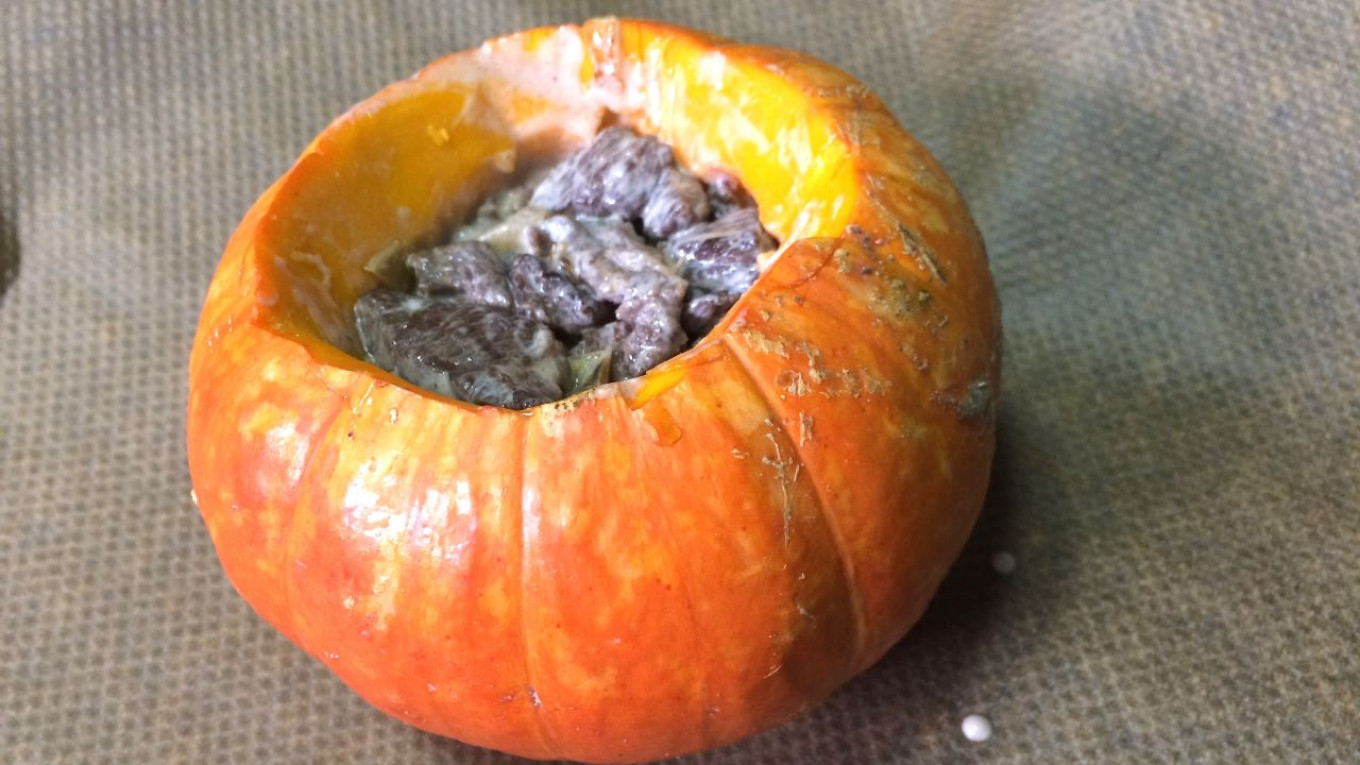
Meat-Stuffed Pumpkin
Ingredients
- 1 pumpkin 3 kg (6.5 lb)
- 2.5 kg (5.5 lb) beef
- 2 onions
- 250 g (generous 1 c) sour cream
- 3 Tbsp melted butter
- 2 Tbsp Worcestershire sauce
- Salt and pepper
For the sauce
- 3 Tbsp balsamic vinegar
- 4 Tbsp olive oil
- 3 Tbsp soy sauce
- 1 tsp honey
- Freshly ground black pepper
Instructions
- Mix all sauce ingredients in a jar, cover tightly and shake until well combined.
- Turn the oven to preheat to 160˚C (325˚F) Cut a circle around the stem of the pumpkin and then scrape out the seeds with a spoon.
- Finely chop the onion. Heat 1 Tbsp melted butter in a skillet and fry the onion until golden. Cut the meat into small pieces. Remove the onions to a plate and fry the meat in the remaining butter until crispy.
- Mix the onion, meat, sour cream, salt and pepper and Worcestershire sauce. Stir it and pack it into the pumpkin. Close tightly with the lid and put in a preheated oven for 1-3 hours, depending on the size of pumpkin.
- The pumpkin should be soft. When ready, take it out and let it rest for 20-30 minutes. To serve, you can cut the pumpkin into slices and serve a slice of pumpkin and meat with sauce. Or, if the pumpkin is small, leave it as is for one serving.
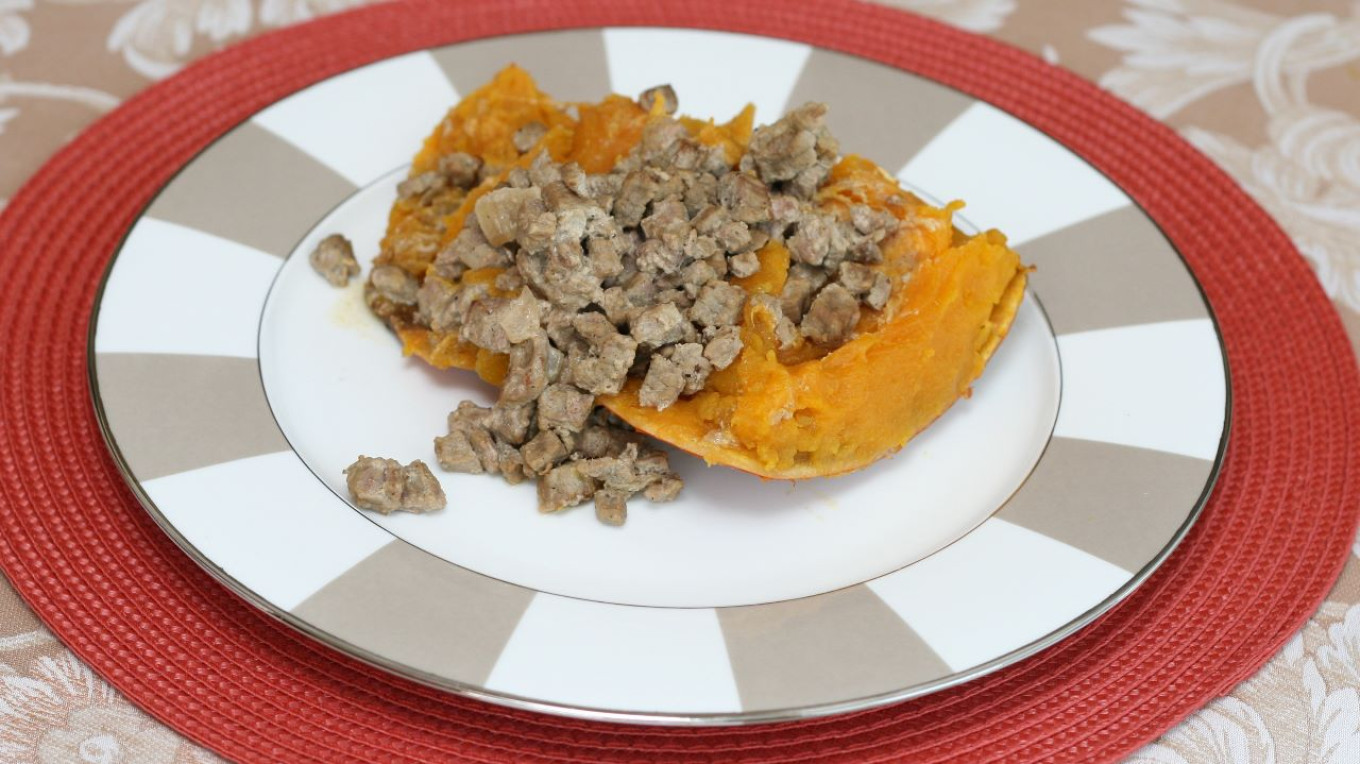
A Message from The Moscow Times:
Dear readers,
We are facing unprecedented challenges. Russia's Prosecutor General's Office has designated The Moscow Times as an "undesirable" organization, criminalizing our work and putting our staff at risk of prosecution. This follows our earlier unjust labeling as a "foreign agent."
These actions are direct attempts to silence independent journalism in Russia. The authorities claim our work "discredits the decisions of the Russian leadership." We see things differently: we strive to provide accurate, unbiased reporting on Russia.
We, the journalists of The Moscow Times, refuse to be silenced. But to continue our work, we need your help.
Your support, no matter how small, makes a world of difference. If you can, please support us monthly starting from just $2. It's quick to set up, and every contribution makes a significant impact.
By supporting The Moscow Times, you're defending open, independent journalism in the face of repression. Thank you for standing with us.
Remind me later.







